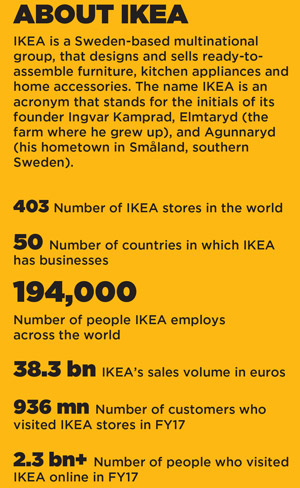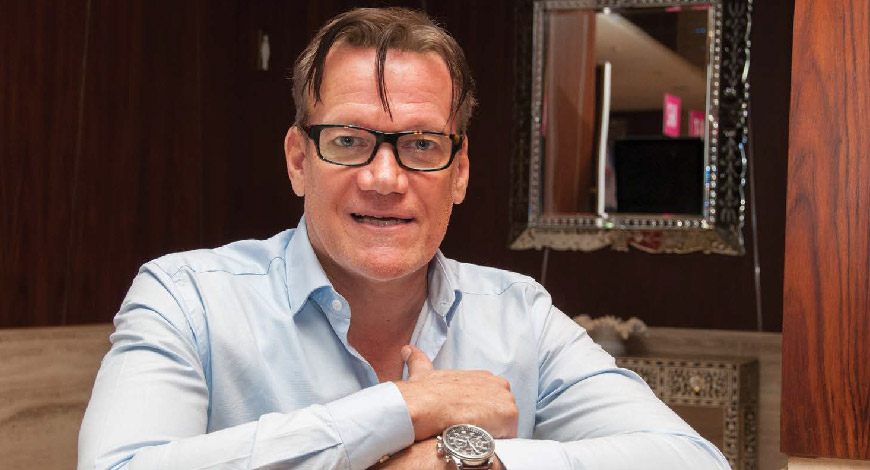The brand has done a lot of ground-work, in an effort to study the Indian market, which is a critical market for it in the global scheme of things. Along with hundreds of house visits, a lot of research and many conversations with consumers, the brand has coined a unique strategy for India, calling it ‘Swedeshi’ – juxtaposing Swedish with ‘desi’.
“For us, the brand’s positioning is all about how we would like people to perceive us. Therefore, we came up with a strategy that has become the merging point between IKEA’s values and Indian values. While as a country and a culture, India is very different from Sweden, we decided to focus on what we had in common. Therefore, ‘Swedeshi’ will be our formula for everything we do here,” explains Ulf Smedberg, Country Marketing Manager, IKEA India.
The brand plans to invest around $1.5 billion in India and wants to expand in the country faster than it has expanded in other parts of the world. Smedberg reveals plans to open a mega Navi Mumbai store within the next six months and launching the next few stores in places like Bangalore, Delhi, Chennai, Kolkata and Pune after that. The brand is also targeting to reach more than 200 million people in India in the next three years.
IKEA will be doing a lot of things differently in India, compared to what it does elsewhere. The 1,000-seater restaurant in its Hyderabad store is going to be its biggest so far. It will have a mix of Indian as well as Swedish-inspired dishes. Moreover, the restaurant will serve food starting from a pricepoint of Rs 10. The aim, elaborates Smedberg, is to drive higher footfalls. “Our endeavour is to reach out to people of all income groups. Also, we want people to come to our store and spend a long time with us. Having a good restaurant with a wide range of things on the menu helps,” Smedberg adds.
The brand also wants to give its digital presence a big push. “We will have a strong focus on digital and plan to take the mobile-first approach. We are investing a lot on our e-commerce platform too, which will go live at the same time that we launch our Mumbai store,” Smedberg explains.
WORKING AROUND THE DIY CONUNDRUM
While IKEA is known across the world for its Do-It-Yourself (DIY) furniture, the concept could fail to take off in India where customers have been used to readymade furniture. The brand’s tie-up with local services marketplace UrbanClap, another first, is aimed at working around this issue. “UrbanClap will help us with the assembling of our products at the best possible price,” Smedberg says. Customers will be able to avail UrbanClap’s services by paying a small, additional amount. “We will tell consumers that they could save some money if they assembled the furniture themselves. We had noticed a similar trend in Korea where people weren’t into the whole DIY culture. However, we organized some classes where we showed people how to do it. A lot of people embraced the concept. We believe the same could happen in India as well,” Smedberg hopes.
Keeping the price-sensitiveness of the Indian market in mind, the brand has come up with a lot of low-cost products. “Our product portfolio for the Indian market will include a lot of low-cost items. Close to 1,000 products will be priced under Rs 200. We want our stores to have something for everybody and we want to make sure that everybody who visits us, finds something for their homes,” says Smedberg.
MAKING EVERYDAY BRIGHTER
 Smedberg reveals that multiple conversations with consumers across India gave him the notion that everybody is looking forward to a brighter tomorrow. “We hijacked the word brighter from our conversations and brought it into our vision. But we also realized just a bright future is not enough. Celebrations are not just around big events or festivals. We should be able to celebrate every day. That’s how we arrived at the phrase ‘A brighter everyday’. We want to become an enabler of a brighter everyday for our Indian customers. We believe that a brand is no longer what we tell consumers. Rather it is what consumers tell each other,” Smedberg states.
Smedberg reveals that multiple conversations with consumers across India gave him the notion that everybody is looking forward to a brighter tomorrow. “We hijacked the word brighter from our conversations and brought it into our vision. But we also realized just a bright future is not enough. Celebrations are not just around big events or festivals. We should be able to celebrate every day. That’s how we arrived at the phrase ‘A brighter everyday’. We want to become an enabler of a brighter everyday for our Indian customers. We believe that a brand is no longer what we tell consumers. Rather it is what consumers tell each other,” Smedberg states. IKEA believes that its own employees are its best ambassadors and has invested in making the deal sweeter for them. A year back, it introduced six months paid paternity leave for male employees, equivalent to six months paid maternity leave. “We are very determined to have an equal gender split, not just in terms of people working in our stores, but also at the management level. So far, our split is 50:50 at IKEA,” Smedberg shares.
FOCUS ON DIGITAL, OOH AND EXPERIENTIAL
While IKEA will launch its TV campaign in the next few days, it will give a lot of importance to Digital, Out-of-Home and Experiential mediums for advertising. This, Smedberg says, is a learning from experience in Hyderabad where various activations and OOH worked well for the brand. “Over time, we will put a lot of focus on Digital. However, in Hyderabad, we realized that people spend a lot of time in the traffic and OOH hoardings and billboards become an effective way of connecting with them. We will soon be launching our TVC which will also be launched on Digital. We will be publishing a brochure called the IKEA edition. This brochure will be distributed every second month to people along with their newspapers,” he adds.
Talking about the marketing strategy that the brand will focus on, Smedberg says it will be all about making people excited about IKEA and all that it has to offer. “It’s primarily about using our competence and knowledge and engaging with people. We want to get more and more people interested in the concept of home furnishings and show to consumers, specially in places like Mumbai, where people live in very small spaces, that you can have a very good life with small storage solutions using the walls, the space under your bed or multi-functional products. It’s all about increasing engagement with people and showing them that we are a lot of fun.”























